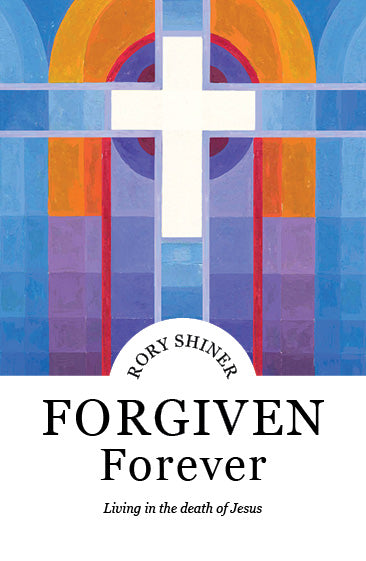I found reading Forgiven Forever: Living in the Death of Jesus by Rory Shiner an important time of reflection on the forgiveness I enjoy in Jesus and an opportunity to delve into why his death was necessary for me to be forgiven. Forgiven Forever is part of a series in which Rory explores the eternal nature of the gifts God gives us in Jesus, including Raised Forever and One Forever.
Reading for Structure and Purpose
Although Forgiven Forever is designed to be read in order, readers can interact with the chapters that interest them the most, first, without subtracting from the flow of the text. Each chapter works through a different aspect of Jesus’ death for the forgiveness of sin, and the implications his death has for our faith, our spiritual life, our holiness, church, and our leadership of others. Over thirteen chapters, Rory provides a systematic breakdown of the circumstances, theology, and context of Jesus’ death and resurrection in an admirably short book.

Forgiven Forever
Rory Shiner
Forgiven Forever
Rory Shiner
Purchase here:
Forgiven Forever: Living in the Death of Jesus
Why is the cross significant? What implications does an ancient crucifixion have for modern lives? Forgiven Forever is a captivating journey through the Bible’s teachings on Jesus’ death and its impact on you today.
You’ll consider key concepts such as forgiveness, atonement, guilt and shame in a new light, as well as topics you might not expect, like Christian leadership, spiritual warfare, and the nature of church.
Reading about Jesus the Person
Chapters 1-3 provide the date, approximate time, and place of the events preceding Jesus’ death. The tone reminded me of a true crime podcast, with its stylistic attention to detail of Jesus’ final hours. I felt curdling dread in my stomach as the events unfolded, punctuated with time stamps, locations, and contextual detail. Starting the book with Jesus facing his last meal, his pleading tears in the garden of gethsemane, his arrest, humiliation, and death on the cross bring a sobering humanity to Jesus’ sacrifice. His death is a murder, and a tragic one, even though Jesus’ submission unto death led to cosmic victory over our sin.
Reading for a Culture Without Forgiveness
Chapters 4-6 provide a detailed Old Testament context for the concept of sacrifice. Understanding the sacrificial system of the temple, sin, offerings, the need for propitiation, and the role of the high priest are essential for fully grasping the significance of Jesus’ work. He is not just the one who provides an appropriate sacrifice to deal with our sin, he is the great high priest who represents us before God. More than that, he is the sin offering slain for us.
These short chapters introduce a loaded and complicated historical context into a simpler form but engage with a culture which seems unable to accept atonement for sin. In a post #metoo and cancel culture era, our society has its own system for dealing with unwanted behaviour. The priests of this system don’t accept atonement offerings.
The social media pile-on is how we send sinners into the desert. No substitute is provided. There is no goat to stand in anyone’s place (p. 58).
Rory argues that our culture understands the power of holiness in phrases like toxic masculinity, cancel culture, and the stain of colonialism. However, the courts of social media create overwhelming burdens of shame and guilt. Incidentally, shame and guilt are what Rory proceeds to deal with in the next chapters.
Reading for Grace, Healing, and Leadership
Chapters 7-9 begin to apply the theology of the previous chapters to the Christian life. Most Christians will struggle with guilt, shame, and assurance of salvation. For Christians who struggle with assurance of salvation, whether due to spiritual attack, or ruminating on sinful past actions, these chapters provide biblical reassurance and a foundation to develop servant leaders who grasp that they are forgiven so that they offer forgiveness to others. Rory uses the example of cult leaders who lead through “charisma, coercion, threat and reward (p. 110)” as a contrast to servant leaders who follow the example of Christ. Dealing with our guilt and shame biblically is a first step to embodying and modelling non-coercive and servant leadership.
Reading to Prepare for the Apocalypse
I loved chapter 11, How to use the Cross in the Event of a Zombie Apocalypse. Using the language of zombie apocalypse helps us recognise the cosmic scale of Christ’s work on the cross, and the battle we remain embroiled in as we live according to Jesus’ teachings in a world that is against Him.
The cross is a battlefield. Not just a standard-issue, nation-versus-nation battlefield, but an all-out Zombie Apocalypse (p. 134).
Even though the evil spiritual forces have already been defeated by the cross and will be wiped out forever on the last day, they still wage war. We live in the time in-between the cross and the last day, with all its pitfalls and risks. We live in the zombie apocalypse.
We are at war against temptation. Sometimes this war is in the form of a demonic attack that we cannot see, other times the war is more obvious. This chapter prepares us for a real fight in the knowledge that we are more than equipped for that fight in Christ. Rory reminds us that our focus should be on the cross in three main ways: recognizing the enemy, the tactical power of the cross against the enemy, and obeying Jesus’ command “Be not afraid (p. 142).”
Reading for Audience
I think that ‘Forgiven Forever’ was written for an educated audience in one of three broad categories. Those who are: 1: investigating the claims of Christianity and are seeking to understand the theology of salvation with greater depth; 2: those new to the faith and seeking to understand the mechanics of forgiveness, particularly as to how Christ’s sacrifice is a fulfilment of Old Testament law and prophecy; 3: those struggling with assurance, doubt or existential anxiety about their status as forgiven people.
Rory’s thoughtfulness and clarity in Forgiven Forever is a blessing to readers. He uses fun and memorable illustrations, metaphors and similes to make his points land well. However, this book isn’t lightweight. The theological depth of the cross is richly explained. Rory’s accessible prose speaks to the heart as well as the mind. However, because of the rich treatment of deep theology in ‘Forgiven Forever’, I think that this book is better suited to university educated readers.
If someone in your congregation thrives on the teaching of this book, it might be time to tap them on the shoulder to consider leadership. Readers of this book will have a strong foundation of the Christian message as well as a deep sense of the servant heart of Christ. Christ didn’t shrink from death and continues to offer forgiveness from the mighty throne of God. Leaders who have grasped and can embody this sacrificial message will have a significant impact on their families, churches, schools, and workplaces, to the Glory of God.















